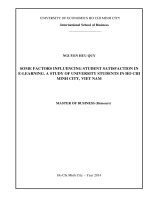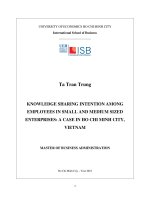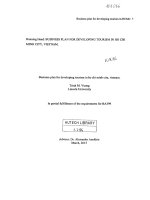Some factors influencing student satisfaction in e learning a study of university students in ho chi minh city, viet nam
Bạn đang xem bản rút gọn của tài liệu. Xem và tải ngay bản đầy đủ của tài liệu tại đây (486.94 KB, 85 trang )
UNIVERSITY OF ECONOMICS HO CHI MINH CITY
International School of Business
------------------------------
NGUYEN HUU QUY
SOME FACTORS INFLUENCING STUDENT SATISFACTION IN
E-LEARNING. A STUDY OF UNIVERSITY STUDENTS IN HO CHI
MINH CITY, VIET NAM
MASTER OF BUSINESS (Honours)
Ho Chi Minh City – Year 2014
UNIVERSITY OF ECONOMICS HO CHI MINH CITY
International School of Business
------------------------------
NGUYEN HUU QUY
SOME FACTORS INFLUENCING STUDENT SATISFACTION IN
E-LEARNING. A STUDY OF UNIVERSITY STUDENTS IN HO
CHI MINH CITY, VIET NAM
ID: 22110050
MASTER OF BUSINESS (Honours)
SUPERVISOR: Dr. Nguyen Dong Phong
Ho Chi Minh City – Year 2014
Acknowledgement
The process of writing this thesis is a challenging task and an insight full research. It
is almost impossible for me to reach the goal and successfully complete the thesis
without the love, the care, the full support, and guidance from my professors and my
friends.
The first person I would like to express a great gratitude is my thesis advisor Dr.
Nguyen Dong Phong for his assistances and guidance in conducting this research and
thanks for his generous as well as his support during the time I take part in studying
here. Dr. Dinh The Hoang is the second person I would like to thanks for his
dedicated guidelines in data analysis section. And further thanks go to the members of
my thesis committee for their feedback, comments and encouragement. The thesis
would not have achieved this quality without their devotion helps.
Great thanks to my best friends in for their helps in my life and study. Special thanks
to responders with enthusiasm to help me collect the data and thanks to special ISB
friends for happy moments we spent together.
Ho Chi Minh City, Mar 2, 2014
Nguyen Huu Quy
i
Abstract
As a matter of fact, thanks to technology innovations and Internet, we cannot deny the
fact that people have many diverse ways to approach courses of universities through
Internet, comprising e-learning, online education. In addition, in Vietnam, students
are increasingly demanding online access, and universities, colleges, and institutions
are working to meet demands. As a result, e-learning is emerging as the new paradigm
of modern education in Vietnam. The purpose of this paper therefore finds the factors
of student satisfaction with e-learning at Vietnam universities.
In order to do this, data of the quantitative survey is gathered from university learners,
having been experienced the e-learning method in one of the biggest cities, Ho Chi
Minh City. Then, the analysis is done via the SPSS software. Next, both the results
and the relations among the factors are explained.
The results are expected to support the proposed hypotheses. They are able to be
essential to provide universities, institutions, and colleges with more information
about the student satisfaction of e-learning in Vietnam. Limitations, discussions and
suggestions will be explained the results in research and practice.
ii
Table of Contents
Acknowledgement……………………………………………………………………i
Abstract………………………………………………………………………………ii
Table of Contents…………………………………………………………………….iii
List of tables………………………………………………………………………….vi
List of figures………………………………………………………………………..vii
Chapter I: Introduction………………………………………………………………..1
1.1 Background……………………………………………………………….1
1.2 Research problem…………........................................................................3
1.3 Research objectives……………….............................................................4
1.4 Scope of the research……………………………………………………..4
1.5 Significance of the research…………………………………………….....5
1.6 Organization of the thesis ………………………………………………...5
Chapter II: Literature review and hypothesis ………………………………………...7
2.1 Elearning…………………………………………………………………..7
2.1.1 Definition of e-learning………………………………………….7
2.1.2 The benefits of e-learning……………………………………......8
2.1.3 E-learning in Vietnam………………………………...…………9
2.2 Student satisfaction……………………………………………………....11
2.3 Theoretical Background of student satisfaction model …………………13
2.4 Factors influencing the student satisfaction with e-learn………………...18
2.4.1 Instructor capability………………………………………...….18
2.4.2 Learner attitude toward computers………………………..…..20
2.4.3 Technology dimension…………………………………………21
2.5 Research model…………………………………………………………..22
iii
Chapter III: Methodology……………………………………………………………24
3.1 Research process...……………………………………………………….24
3.2 Preliminarily qualitative research………………………………………...27
3.3 Sampling design………………………………………………………….27
3.4 Measurement……………………………………………………………..28
3.5 Quantitative Research ………………………………………………...…28
3.6 Data analysis……………..........................................................................29
Chapter IV: Research Results …………………………………………………...…..30
4.1 Data statistical analysis…………………………………………………..30
4.2 Cronbach’s Alpha coefficient of reliability test………………………… 32
4.3 Exploratory Factor Analysis ( EFA) result………………………………35
4.4 Independence of residual………………………………………………...38
4.5 Test of normality of residual and heteroscedasticity…………………….39
4.6 Multicollinearity test……………………………………………………..39
4.7 No significant outliers or influential points………………………………40
4.8 Hypotheses Testing……………………………………………………....41
4.9 Summary of the Results………………………………………………… 43
Chapter V. Discussion, Implications, Limitation, and Conclusion…………………. 46
5.1 Discussion ………………………………………………………………. 46
5.2 Implications and suggestions……………………………………………. 47
5.2.1 Instructor capability…………………………………………… 47
5.2.2 Learner attitude toward computers……………………………..49
5.2.3 Technology dimension………………………………………....50
5.3 Conclusion……………………………………………………………….51
5.4 Limitaions…………………………………………………………….......52
iv
References…………………………………………………………………………....54
Appendix A. Questionnaire…………………………………………………………..60
Appendix B: Chart……………………………………………………………………67
Appendix C: Table…………………………………………………………………...70
Appendix D: Preliminarily research………………………………………………….73
v
List of tables
Table 4.1.1: Description…………………………………………………………… 31
Table 4.2.1: Reliability Statistics…………………………………………………... 33
Table 4.2.2: Item-Total Statistics………………………………………………….. 33
Table 4.2.3: Reliability Statistics…………………………………………………....33
Table 4.2.4: Item-Total Statistics…………………………………………………....34
Table 4.2.5: Reliability Statistics………………………………………………….. 34
Table 4.2.6: Item-Total Statistics………………………………………………….. 34
Table 4.2.7: Reliability Statistics…………………………………………………... 35
Table 4.2.8: Item-Total Statistics…………………………………………………... 35
Table 4.3.1: KMO and Bartlett's Test ………………………………………………36
Table 4.3.2: Total Variance Explained…………………………………………….. 37
Table 4.4.1: Model Summary ………………………………………………………39
Table 4.6.1: Coefficients…………………………………………………………… 40
Table 4.7.1: Casewise Diagnostics………………………………………………….40
Table 4.8.1: ANOVA………………………………………………………………. 41
Table 4.9.1: Results of the Testing Hypotheses……………………………………. 44
vi
List of Figures
Figure 2.3.1. Partial model of student satisfaction and retention…………………...14
Figure. 2.3.2. A conceptual model of user’ satisfaction, behavioral intention, and
effectiveness toward e-learning……………………………………………………..15
Figure 2.3.3: Research model……………………………………………………….16
Figure. 2.3.4. Dimensions and antecedents of perceived e-learner satisfaction…….17
Figure 2.5.1: Factors of e-learner satisfaction model………………………………23
Figure 3.3.1: The Structure of the Method approach for this Research……………. 26
Figure 4.9.2: The final research model……………………………………………...45
vii
Chapter I. Introduction
1.1 Background
As a matter of fact, it is almost impossible for governments to develop their
countries in all aspects without paying attention to education. In other words,
education is viewed as means for growing the society, economy, and politics of a
country. The crucial of education and its delivery to the citizens is therefore
imperative. Moreover, modern society requires people to be able to study regularly,
continuously and all their life. In addition, its core is self-learning, self-striving ability
to improve specialty, professional skills and quality of life. E-learning is one of the
methods satisfying these demands. To build a successful learning society in Viet
Nam, the State and Party have concerned very much. According to the eleventh
Congress of Communist Party of Viet Nam (2011), promoting the study
encouragement movement, building a learning society, and expanding e-learning
mode would be goals of the State.
Vietnam’s movement toward a market-oriented economy and participation in
the World Trade Organization (WTO) have opened the doors to greater opportunities
as well as challenges for business. To be more precise, new markets for goods and
services exports, access to imported raw materials and technologies, and more
chances for international business co-operation are opportunities when Vietnam is a
market-oriented economy and a member of WTO. A more open market, however,
leads to stronger competition and to imposition of stricter business standards, such as
product quality and safety (Nguyen, & Nguyen, 2010). Among several challenges,
lack of knowledge about business management is possibly one of the most difficulties
for Vietnam. In addition, the rising demand of people in updating knowledge and
skills has been enormous since Vietnam opened its market. Vietnamese universities,
1
hence, play an important role in providing qualified business graduates for the
Vietnamese labor market (Nguyen, 2009). Knowing the labor market’s need for
competent learners, the Vietnamese universities and colleges make constant efforts to
satisfy customers, especially students.
According to the education laws in 2012, higher education covers
undergraduate and postgraduate studies. Master degrees and doctor degrees belong to
postgraduate studies. In contrast, undergraduate studies can lead to diplomas and
bachelor degrees. In Vietnam higher education system, the structure of higher
education institutions is including universities, research institutions, and colleges.
Universities can offer college, undergraduate, master and doctor programs as assigned
by the Prime Minister. Research institutions can afford doctorate programs. In
addition, the institutions cooperating with universities can make available master
programs subject to permission from the Prime Minister. Unlike universities and
institutions, colleges can offer college degrees and other lower level of undergraduate
programs. Over the past 11 years, higher education, and the tertiary education
institutes system in Vietnam have experienced many changes, consisting of expansion
as well as establishment of new educational institutions with diversified types and
improvement in quality (Nguyen, Oliver, and Priddy, 2009). According to the
statistics of Ministry of Education and Training, Vietnam has about 386 universities
and colleges. Furthermore, nowadays, thanks to technology innovations and Internet,
it is easily for people to study at universities. To be more precise, we can have many
diverse ways to approach courses of universities through Internet, comprising elearning, online education. Online education has generated huge excitement in the
education system. Some people think that it offers the potential to provide learning to
new audiences, while others believe that it offers the opportunity fundamentally to
2
transform learning delivery and the competitive landscape (Poehlein, 1996). The rapid
growth of the Internet, combined with the increasing interest in lifelong learning and
budget restriction, has created a significant incentive for universities to apply elearning in some subjects and academic disciplines. As the modern technologies are
now available and relatively user-friendly, those universities without embracing the
technologies will be left behind in the race for globalization and technological
development.
1.2 Research problem
E-learning is making use of technology innovations and Internet to deliver
information for education and training (Sun, Tsai, Finger, Chen, & Yeh, 2006).
Thanks to the progress of information and communication technology development, it
is impossible for people to deny the fact that e-learning is emerging as the paradigm
of modern education. As regards e-learning, it actually has some advantages,
comprising liberating interactions between learners and instructors, or learners and
learners, from limitations of time and space through the asynchronous and
synchronous learning network model (Sun et al., 2006). It is obvious that the
characteristics of e-learning fulfill the requirements for learning in a modern society.
However, some students feel unpleased and disappointed when experiencing elearning at Vietnamese universities, including: University of Science Ho Chi Minh
city, Ho Chi Minh city Open University, Hutech University, Ho Chi Minh city
University of Technology, and University of Information Technology.
The researches about student satisfaction are vital in ascertaining whether
colleges and universities are fulfilling their mission. It is well known that a qualified
graduate is the most crucial product of educational institutions. Satisfaction is a
relevant measure because many studies have showed that other factors being equal,
3
satisfied individuals are likely to be willing to exert more effort than unsatisfied
individuals (Bryant, 2006; Ozgungor, 2010). Thus, satisfied students have ability to
make more effort to study by taking actions, including regularly attending their
classes and becoming more involved in their coursework.
Consequently, exploring the elements influencing the satisfaction of
Vietnamese students is a need for academics and university administrators as well.
For that reason, the purpose of this study is to investigate some important factors of
satisfaction of Vietnamese students. To be more specific, it examines the impact of
some dimensions, including instructor dimension, learner dimension, and technology
dimension on the e-learner satisfaction.
1.3 Significance of the research
It is obvious that the research play an certain role in the education aspect. To
be more precise, the results of the research will help universities understand clearly
about the components affecting to satisfaction of e-learner. In addition, the results also
show institutions how to improve learner satisfaction and further strengthen their elearning implication. In other words, the findings of the study will help universities
recognize the vital role of applying technology innovations in teaching, and having
suitable policies in order to train and upgrade teaching capability of instructors.
1.4 Research objectives
According to above-mentioned discussion, this study aims to figure out what
are key factors associated with e-learners’ satisfaction firstly and then, identify the
strength of each factor on student satisfaction with e-learning. In details, the main
objectives to this study are:
To examine the factors impacting student satisfaction in e-learning in
Vietnam, including teaching capability, course organization, student-instructor
4
interaction, learner attitude toward technology, technology quality, and internet
quality.
1.5 Scope of the research
Ho Chi Minh City is one of the major business and education centers in
Vietnam, so the empirical in this particular research is the e-learning in the context of
Ho Chi Minh city. To be more specific, the population of this study is the e-learning
students from Ho Chi Minh. In other words, the data collected from the universities in
the city and put into the analysis. The last point needs to be mentioned in the research
scope is that the object of study and survey is focused on the post-graduate students,
and the graduated students; others types of students in the university are not
considered in the thesis.
1.6 Organization of the thesis
The paper’s organization is constructed in five parts. The first is the
introduction of the study. The second is the literature review and hypothesis. The
methodology is the following part. The next part is the research results. The final one
is discussions, implications, limitations, and conclusion.
Chapter 1 – Introduction
This chapter reflects the current situation of education in Vietnam, as well as
discusses about the existing researches in e-learning. As a result, it leads to propose
the research problem, research objectives and significance of this study also presented
in this section.
Chapter 2 – Literature review and hypothesis
In this chapter, the theoretical foundation of the research, including the
definition of each concept, namely, instructor capability, learner attitude towards
computers, technology quality, internet quality, and learner satisfaction in e-learning
5
context, and their relationships in literature are presented or showed. From that, the
hypotheses are derived and proposed for this research.
Chapter 3 – Methodology
There is no doubt that chapter 3 describes the way of establishment of the
measures and conducting the survey. This part includes two steps, qualitative research
to modify draft measurement scale and quantitative research design to test the
hypotheses.
Chapter 4 – Research results
The findings of this research are showed in this chapter. The results are
exhibited corresponding to each step of the data analysis. As a result, the research
hypotheses are tested.
Chapter 5 – Discussions, Implications, Conclusion, and Limitations
The last chapter of this study discusses the research results by affirming the
exploratory values as well as connecting to the realistic conditions to suggest the
practical application. Limitations in the chapter are recognized in order to direct for
further research in the future. Finally, the generalization about e-learning is performed
in conclusion.
6
Chapter II. Literature review and hypothesis
According to the objectives of this study, the research tries to review and
explore the e-learning subject, and student satisfaction with it in the developing
country – Vietnam.. In addition, models and factors impacting satisfaction are
concerned. In the mean time, the hypotheses are formulated, proposed, and discussed.
2.1 E-Learning
2.1.1 Definition of E-learning
In essence, e-learning is the most recent evolution of distance learning. To be
more specific, distance learning is a learning situation where instructors and learners
are separated by distance, time, or both ( Raab, Ellis, & Abdon, 2002). E- learning
uses net-work technologies to create, foster, deliver, and facilitate learning, anytime
and anywhere. In other words, it can be thought to be basically a web-based system
that makes available information or knowledge to users or learners and disregards
time restrictions or geographic proximity (Sun et al., 2006). Similarly, Burgess and
Russell (2003) states that e-learning allows institutions and universities to deliver
education and training consistently to all learners; to update training content when
necessary; to reduce travel costs to outside training facilities; and to provide training
to students on demand, anytime and anywhere. For instance, e-learning can be made
full use of its own ability to present online lectures through the use of live stream
audio and video technology, textual materials in the form of electronic PowerPoint
slides, and discussions through the use of message boards and chat rooms. Many
researchers from psychology and information system fields have recognized
important variables dealing with e-learning. Some of them have partially contributed
to understanding e-Learning success, such as the technology acceptance model (Ajzen
& Fishbein, 1977; Davis, Bagozzi, & Warshaw, 1989; Oliver, 1980), and the
7
expectation and confirmation model (Bhattacherjee, 2001; Lin, Wu, & Tsai, 2005;
Wu et al., 2006).
2.1.2 The benefits of e-learning
Many articles have discussed about the benefits of e-learning (Liaw, Huang, &
Chen, 2007). According to Bouhnik and Marcus (2006), e-learning has some
advantages, including: freedom to decide when each online lesson will be learned;
lack of dependence on the time constraints of the lecturer; freedom to express
thoughts and ask questions without limitations; the accessibility to the course’s online
materials at students’ own election. Similarly, Capper (2001) explores the e-learning
benefits, such as any time, any place, asynchronous interaction, group collaboration,
new educational approaches. To be more precise, any time means that a participant
can access the learning program at any time, that is convenient for learners. Any place
is that the participants do not have to meet. Asynchronous interaction is understood
that interactions can be more succinct and discussion can stay more on-track. Group
collaboration means that electronic messaging creates new opportunities for groups to
work together by creating shared electronic conversations and discussions. New
educational approaches show that many new options and learning strategies become
economically feasible through online courses. They also can provide unique
opportunities and learners to share innovations in their own works with the immediate
support of electronic groups.
There are many innovations and improvements compared with traditional
forms of learning, e-learning promises to provide students with the perfect
combination of visual, audio and proactive. E-learning makes training to be more
effective for different learners, cut the cost of printing, publishing and distribution.
The online learning can actively select those suitable for learners’ knowledge than
8
passive forms applied in the classroom. In addition, the e-learning sync helps learners
to be able to control high through put you suitable learning rate, ignoring the simple
instructions unnecessary and still meet the overall progress of the courses. Moreover,
cost saving training is also an advantage that brings e-learning. Teacher salaries,
classroom rental costs, travel expenses, accommodation for students, and reducedproductivity costs due to loss of time students have to go to school are other
advantages of e-learning (Thuy, 2010). In other words, the advantages of e-learning
are including: making full use of high quality faculty resources from around the
world, reducing learning time of about 40-60 %, consistent content transmission in
accordance with the requirements of the school; completing results training programs
automated ,and informing to learners accurately and objectively (Thuy, 2010). For
students, accompanied by an increase in the ability to continue to meet the job,
reducing time, students can learn anytime, anywhere allowing students to complete a
training program upon overtime work or at home.
2.1.3 E-learning in Vietnam
Along with the explosion of information technology and communications,
online training is a type should be expanded to provide opportunities for learners to
self-study, self- study and cram. Growing social, educational needs of the growing
population, but the school system has been investing boom in quantity and quality,
but also cannot meet the learning needs most types of learners. Due to these facts, the
orientation of the Party is the promotion of learning movement in the form of people
with formal education and non-formal, implementing education for everyone, and a
learning society in the country (Tam, 2013). From the above directions, the Sector of
Education and Training has developed strategies for educational development. It has
emphasized that development of non-formal education provided as a form of
9
mobilization potential of the community, to build social learning opportunity for
people of all abilities, all ages, anywhere can lifelong learning, appropriate to the
circumstances and conditions of each individual, contributing their knowledge and the
quality of human (Tam, 2013). E-learning is one of the training methods contribute to
achieving this goal.
With Vietnam joining the WTO and integration into the world economy
deeper, Vietnam's education is facing the challenge of training the future citizens have
sufficient ability, intelligence, self- school, in order to upgrade their environment
increasingly fierce competition. Forms of e-learning are not strangers around the
world. According to Elearn (2010), nearly 90% of universities in Singapore have elearning and this method used in USA is over 80 %. In Vietnam, the stormy
development of information technology leads to skyrocketing Internet users. Along
with this rapid growth, how to work, study, entertainment of Internet users in Vietnam
changed with the new formula. Today, in Vietnam, people can find e-learning
programs via three main channels, comprising: the courses from the universities, the
programs from overseas into Vietnam, and the courses established by companies.
The Vietnam Ministry of Education and Training also had many positive
moves to encourage bringing information technology into teaching, bringing the
knowledge of online learning to the managers, teachers who care about education and
students. Currently, the Ministry has built the e-learning website (el.edu.net) to
disseminate and access technology. Vietnam has turned open source software Moodle
to build and manage an online learning system. Moreover, the Ministry has used
technologies SCORM, recognized worldwide, to develop and cooperate in the field of
information technology (Thuy, 2010). The managers have been ongoing transferring
software of tool to create free lectures, reaching international standards. This helps to
10
publish the compliant formats of file SCORM, such as Exe , Lectora , Voilet, etc,
consistent with the needs of our country. Ministry of Education and Training has
linked fiber optic cable connects 34 Mbps, and 2 Mbps in order to go abroad. Viettel,
the national information technology cooperation, offers highest quality packages of
NET to the educational institutions. Connecting optical cable from the Ministry of
Education and Training Department is four Mbps (elearn, 2010).
Unlike the developed countries, such as Singapore, Taiwan, USA, etc, elearnig in Vietnam is not still in the high level. In addition, e-learning in Vietnam has
to face trouble, such as the low quality and quantities, the limitation of scope and elearner participation, the lack of necessary facilities. The other problems of e-learning
in Vietnam are that the rate of online interaction between teachers and students on the
network is not high, the answers must be done cold guide, the lack of methodology
and teaching staff remains universities. Some universities run achievement, have
development scale much faster than their ability to ensure the quality of training,
compared with the conditions of teaching staff members and teaching assistants
(Thuy, 2010). Appreciating the true worth of universities’ quality in e-learning still
remains limitations. This is an extremely practical difficulty in the e- learning process.
As a consequence, many people doubt the quality of e-learning, and have e-learning
dissatisfaction.
2.2 Student satisfaction
To begin with, student satisfaction, student perception of quality, and student
self-confidence are simple ideas to gasp. However, there are a large number of articles
making an attempt to clarify these concepts, develop measures to quantify them, and
determine what their impact is on one another and on other constructs. Concepts that
are seemingly clear to everyone suddenly are more difficult to define and isolate.
11
One of the quoted definitions of satisfaction is that offered by Hunt (1977,
p.49): “Consumer satisfaction with a product refers to the favorableness of the
individual’s subjective evaluation of the various outcomes and experiences associated
with buying it or using it”. Similarly, Tse and Wilton (1988) defined the customer
satisfaction:” The consumer’s response to the evaluation of the perceived discrepancy
between prior expectations (or some norm of performance) and the actual
performance of the product as perceived after its consumption” (p.204).
As regards the context of education, student satisfaction refers to the
favorability of a student’s subjective evaluations of the various outcomes and
experiences associated with education (Oliver & DeSarbo, 1989). Since satisfaction is
based on experience, student satisfaction is constantly being by the students’ overall
experiences (Oliver, 1980) and, as Seymour (1993) noted, what happens to students in
the classroom and with their academic choices is not independent of all other
experiences on campus life and the combination of all experiences affects the overall
satisfaction with the university. According to Parasuraman et al., (1985, 1988),
customer satisfaction is based on the disconfirmation of consumer expectations in
what widely known: satisfaction occurs when perceived performance meets or
exceeds the student’s expectations and dissatisfaction results when there is a negative
gap between performance and expectation.
While student satisfaction is regarded as a short-term attitude resulting from
the student’s educational experience, perceived quality is a general perception often
affected by objective information and reputation and not necessarily tied to personal
experience. For government officials and administrators alike, program quality is
often linked to objective achievements, retention rare, time to graduate, enrollment
12
trends, average starting salaries of graduates, percentage of students going to graduate
programs, and passing rates on professional consumer satisfaction (Letcher & Neves).
Similarly, Astin (1993) defines student satisfaction as the students’ perceived
value of their educational experiences at a university. According to Muilenburg &
Berge (2005), there are significant differences that still exist in the way students
perceive their online experiences during e-learning. It is doubt that perceptions about
their learning experiences can affect students in their making decision to continue
with the course whether or not (Carr, 2000). It can also influence levels of satisfaction
with overall online learning experiences (Kenny, 2003). Generally, in the context of
the research, student satisfaction can be understood that it is the students’ perceived
value of their online experiences during e-learning.
2.3 Theoretical Background of student satisfaction model.
In the online-learning environment, it obvious that there are some several
elements affecting student satisfaction. Bolliger and Martindale (2004) identifies that
three key factors central to e-learner satisfaction, including: the instructor, technology,
and interactivity. Other components are communication with all other course
constituents, course management issues, and course websites or course management
systems used. According to Liaw (2008), students’ perception of task value and selfefficacy, social ability, quality of system, and multimedia instruction have been
identified as crucial constructs. Students also need to be confident that they can be
successful in the online learning environment (Bolliger & Wasilik, 2009). Student
satisfaction is linked to the students’ performance, and student satisfaction is an vital
element in the investigation of faculty satisfaction. According to Bolliger and Wasilik
(2009), the correlation between faculty satisfaction and student learning is quite high.
13
Actually, there are many researchers from psychology and information system
fields have identified essential variables affecting student satisfaction. The below
figures (including: figure 2.3.1, figure 2.3.2, figure 2.3.3, and figure 2.3.4) are
available models that describe factors impacting student satisfaction.
FACULTY
- Understanding
- Accessible
- Helpful
- Provide feedback
ADVISING STAFF
- Accessible
- Reliable
- Helpful
- Responsive
- Understanding
STUDENT PARTIAL
COLLEGE EXPERIENCE
- Cognitive development
- Career progress
- Business skills
SATISFACTION
CLASSES
- Real-World relevance
- Course scheduling
- Projects/cases ( skills)
Figure 2.3.1. Partial model of student satisfaction and retention (Oscar, Ali, &
Erdener, 2005).
According to Oscar, Ali, & Erdener (2005), the model of figure 2.3.1 is
focused on the links between faculty, advising staff, and classes so that the
researchers can consider the impact of these critical factors on students’ experience
with universities, which in turn affects student satisfaction. In other words, they use
the model to consider the influence of unique set of variables to explain part of the
college experience in higher education institutions on student satisfaction.
14
Learners’
characteristics,
such as selfefficacy, selfdirectedness, etc.
Environmental
factors, such as
multimedia
instruction,
system quality,
synchronous,
and/or
asynchronous
interaction, etc.
Perceived
satisfaction
Behavioral
intention of
using elearning
Perceived
usefulness
E-learning
effectiveness
Figure. 2.3.2. A conceptual model of user’ satisfaction, behavioral intention, and
effectiveness toward e-learning ( Liaw, 2008).
Liaw (2008) proposes a conceptual model for investigating satisfaction,
behavioral intention, and e-learning effectiveness among learners (figure 2.3.2). The
figure shows that learners’ perceived satisfaction and perceived usefulness of a
product will be influenced by learners’ characteristics. In the conceptual model,
perceived satisfaction, perceived usefulness and e-learning effectiveness will also
affected by environmental characteristics. Moreover, the model shows that the
perceived satisfaction and perceived usefulness will positively impact learners’
behavioral intention of e-learning usage ( Liaw, 2008).
15
Student selfmotivation
Student
learning style
Perceived
student
satisfaction
Instructor
knowledge and
facilitation
Instructor
feedback
Learning
outcomes
Interaction
Course
structure
Figure 2.3.3: Research model ( Eom, Ashill, and Wen, 2006).
The figure 2.3.3 illustrates factors potentially affecting e-learning outcomes
and perceived student satisfaction. To be more specific, the primary objective of the
researchers in the model is to investigate essential elements of students’ perceived
learning outcomes and satisfaction university online education using e-learning
systems. The research model consists of factors, comprising: student self-motivation,
student learning style, instructor knowledge and facilitation, instructor feedback,
interaction, and course structure.
16









